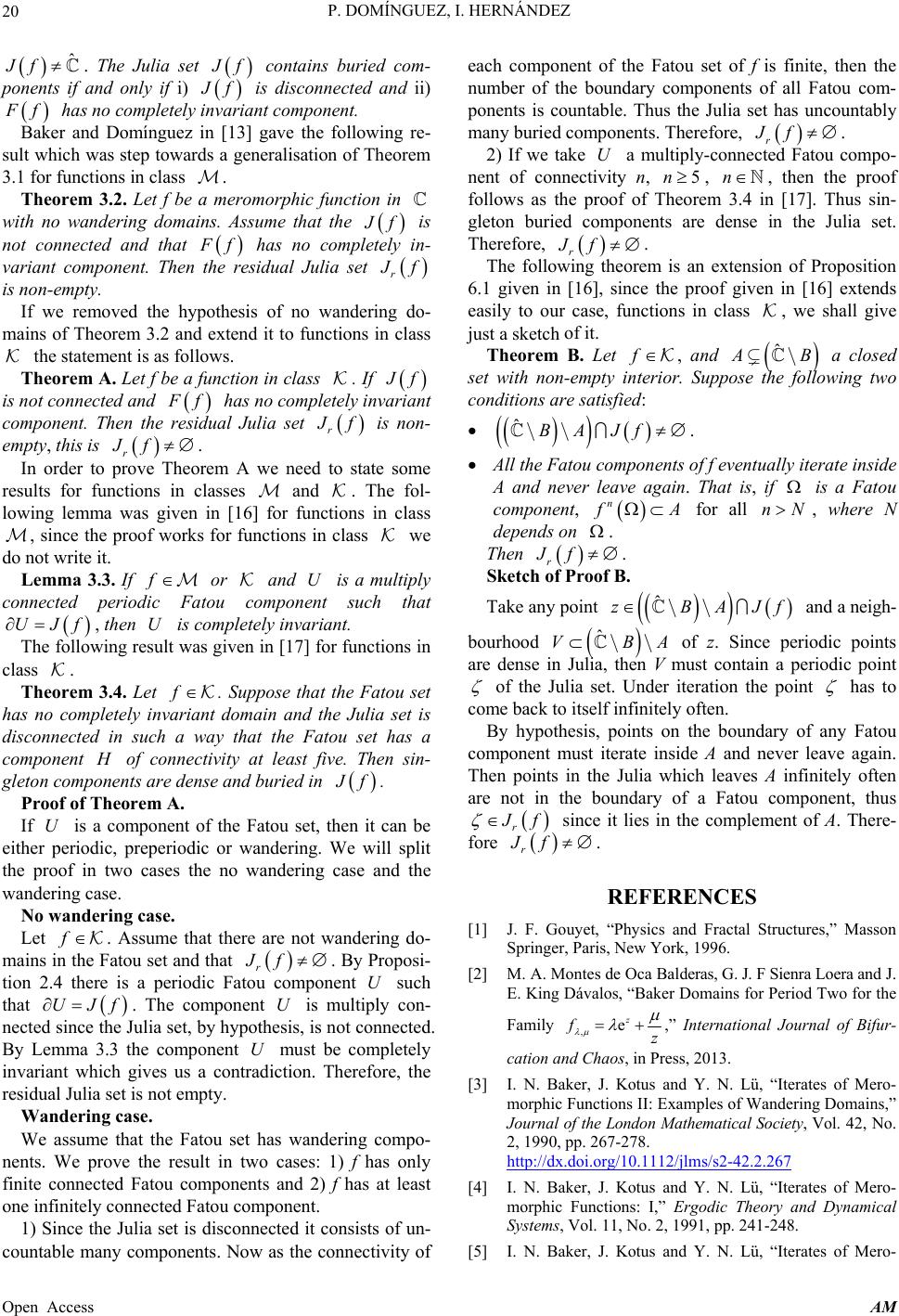
P. DOMÍNGUEZ, I. HERNÁNDEZ
20
ˆ
Jf. The Julia set
f
contains buried com-
ponents if and only if i)
f is disconnected and ii)
f has no completely invariant component.
Baker and Domínguez in [13] gave the following re-
sult which was step towards a generalisation of Theorem
3.1 for functions in class .
Theorem 3.2. Let f be a meromorphic function in
with no wandering domains. Assume that the
f is
not connected and that
f has no completely in-
variant component. Then the residual Julia set
r
f
is non-empty.
If we removed the hypothesis of no wandering do-
mains of Theorem 3.2 and extend it to functions in class
the statement is as follows.
Theorem A. Let f be a function in class . If
f
is not connected and
f has no completely invariant
component. Then the residual Julia set
r
f is non-
empty, this is .
r
Jf
In order to prove Theorem A we need to state some
results for functions in classes and . The fol-
lowing lemma was given in [16] for functions in class
, since the proof works for functions in class we
do not write it.
Lemma 3.3. If or and U is a multiply
connected periodic Fatou component such that
, then is completely invariant.
f
U
UJf
The following result was given in [17] for functions in
class .
Theorem 3.4. Let . Suppose that the Fatou set
has no completely invariant domain and the Julia set is
disconnected in such a way that the Fatou set has a
component
f
of connectivity at least five. Then sin-
gleton components are dense and buried in
f.
Proof of Theorem A.
If is a component of the Fatou set, then it can be
either periodic, preperiodic or wandering. We will split
the proof in two cases the no wandering case and the
wandering case.
U
No wandering case.
Let . Assume that there are not wandering do-
mains in the Fatou set and that . By Proposi-
tion 2.4 there is a periodic Fatou component such
that . The component is multiply con-
nected since the Julia set, by hypothesis, is not connected.
By Lemma 3.3 the component must be completely
invariant which gives us a contradiction. Therefore, the
residual Julia set is not empty.
f
UJ
r
Jf
U
U
U
f
Wandering case.
We assume that the Fatou set has wandering compo-
nents. We prove the result in two cases: 1) f has only
finite connected Fatou components and 2) f has at least
one infinitely connected Fatou component.
1) Since the Julia set is disconnected it consists of un-
countable many components. Now as the connectivity of
each component of the Fatou set of f is finite, then the
number of the boundary components of all Fatou com-
ponents is countable. Thus the Julia set has uncountably
many buried components. Therefore, .
r
Jf
2) If we take a multiply-connected Fatou compo-
nent of connectivity n, , , then the proof
follows as the proof of Theorem 3.4 in [17]. Thus sin-
gleton buried components are dense in the Julia set.
Therefore,
U5nn
r
Jf
.
The following theorem is an extension of Proposition
6.1 given in [16], since the proof given in [16] extends
easily to our case, functions in class , we shall give
just a sketch of it.
Theorem B. Let f
, and
ˆ
B a closed
set with non-empty interior. Suppose the following two
conditions are satisfied:
ˆBA Jf
.
All the Fatou components of f eventually iterate inside
A and never leave again. That is, if is a Fatou
component,
n
A
for all nN, where N
depends on
.
Then
r
Jf
.
Sketch of Proof B.
Take any point
ˆ
zBAJ f
and a neigh-
bourhood
ˆ
VBA
of z. Since periodic points
are dense in Julia, then V must contain a periodic point
of the Julia set. Under iteration the point
has to
come back to itself infinitely often.
By hypothesis, points on the boundary of any Fatou
component must iterate inside A and never leave again.
Then points in the Julia which leaves A infinitely often
are not in the boundary of a Fatou component, thus
r
f
since it lies in the complement of A. There-
fore
r
Jf
.
REFERENCES
[1] J. F. Gouyet, “Physics and Fractal Structures,” Masson
Springer, Paris, New York, 1996.
[2] M. A. Mo n tes de Oc a Ba lderas, G. J. F Sienra Loera and J.
E. King Dávalos, “Baker Domains for Period Two for the
Family ,ez
fz
,” International Journal of Bifur-
cation and Chaos, in Press, 2013.
[3] I. N. Baker, J. Kotus and Y. N. Lü, “Iterates of Mero-
morphic Functions II: Examples of Wandering Domains,”
Journal of the London Mathematical Society, Vol. 42, No.
2, 1990, pp. 267-278.
http://dx.doi.org/10.1112/jlms/s2-42.2.267
[4] I. N. Baker, J. Kotus and Y. N. Lü, “Iterates of Mero-
morphic Functions: I,” Ergodic Theory and Dynamical
Systems, Vol. 11, No. 2, 1991, pp. 241-248.
[5] I. N. Baker, J. Kotus and Y. N. Lü, “Iterates of Mero-
Open Access AM